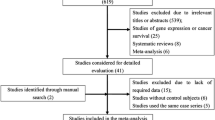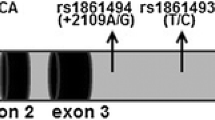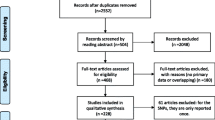Abstract
This meta-analysis aimed to assess the association of common TLR9 and TLR2 gene polymorphisms (TLR9 1486 T/C, TLR9 G2848A, and TLR2–196 to −174 del/ins) with cervical cancer risk. Studies were searched in Scopus, Pubmed, Embase, and CNKI until December 2017. Both fixed-effects and random-effects models were applied to combine odds ratio (OR) and 95% confidence intervals (95% CI). A total of 11 studies including 7856 participants were identified. The pooled estimation revealed an increased risk of cervical cancer in Caucasian subjects carrying the C allele of the TLR9 1486 T/C polymorphism (OR = 1.46, 95% CI: 1.11–1.92, p = 0.007), while there was a decreased risk in Mixed subjects carrying the C allele (OR = 0.35, 95% CI: 0.15–0.82, p = 0.016). Concerning the TLR9 G2848A polymorphism, the A allele was associated with an increased risk of cervical cancer in Caucasians (OR = 1.19, 95% CI: 1.02–1.40, p = 0.030), whereas Asian and Mixed subjects showed no significant associations. No significant associations were demonstrated between the TLR2–196 to −174 del/ins polymorphism and cervical cancer. Our findings suggest that the TLR9 1486 T/C and G2848A polymorphisms contribute to cervical cancer risk, but there is no association of the TLR2–196 to −174 del/ins polymorphism with cervical cancer.





Similar content being viewed by others
References
Ferlay J, Soerjomataram I, Dikshit R, Eser S, Mathers C, Rebelo M, Parkin DM, Forman D, Bray F (2015) Cancer incidence and mortality worldwide: sources, methods and major patterns in GLOBOCAN 2012. Int J Cancer 136(5):E359–E386
Patel JP, Lee EH, Mena CI, Walker CN (2017) Effects of metformin on endothelial health and erectile dysfunction. Transl Androl Urol 6(3):556–565
Yu L, Chen S (2008) Toll-like receptors expressed in tumor cells: targets for therapy. Cancer Immunol Immunother 57(9):1271–1278
Hasan UA, Bates E, Takeshita F, Biliato A, Accardi R, Bouvard V, Mansour M, Vincent I, Gissmann L, Iftner T, Sideri M, Stubenrauch F, Tommasino M (2007) TLR9 expression and function is abolished by the cervical cancer-associated human papillomavirus type 16. J Immunol 178(5):3186–3197
Lee JW, Choi JJ, Seo ES, Kim MJ, Kim WY, Choi CH, Kim TJ, Kim BG, Song SY, Bae DS (2007) Increased toll-like receptor 9 expression in cervical neoplasia. Mol Carcinog 46(11):941–947
Fehri E, Ennaifer E, Ardhaoui M, Ouerhani K, Laassili T, Bel Haj Rhouma R, Guizani I, Boubaker S (2014) Expression of toll-like receptor 9 increases with progression of cervical neoplasia in Tunisian women--a comparative analysis of condyloma, cervical intraepithelial neoplasia and invasive carcinoma. Asian Pac J Cancer Prev 15(15):6145–6150
Ghosh A, Dasgupta A, Bandyopadhyay A, Ghosh T, Dalui R, Biswas S, Banerjee U, Basu A (2015) A study of the expression and localization of toll-like receptors 2 and 9 in different grades of cervical intraepithelial neoplasia and squamous cell carcinoma. Exp Mol Pathol 99(3):720–724
de Matos LG, Cândido EB, Vidigal PV, Bordoni PH, Lamaita RM, Carneiro MM, da Silva-Filho AL (2017) Association between toll-like receptor and tumor necrosis factor immunological pathways in uterine cervical neoplasms. Tumori 103(1):81–86
Hasimu A, Ge L, Li QZ, Zhang RP, Guo X (2011) Expressions of toll-like receptors 3, 4, 7, and 9 in cervical lesions and their correlation with HPV16 infection in Uighur women. Chin J Cancer 30(5):344–350
DeCarlo CA, Rosa B, Jackson R, Niccoli S, Escott NG, Zehbe I (2012) Toll-like receptor transcriptome in the HPV-positive cervical cancer microenvironment. Clin Dev Immunol 2012:785825
Mantel N, Haenszel W (1959) Statistical aspects of the analysis of data from retrospective studies of disease. J Natl Cancer Inst 22(4):719–748
DerSimonian R, Laird N (1986) Meta-analysis in clinical trials. Control Clin Trials 7(3):177–188
Pandey S, Mittal RD, Srivastava M, Srivastava K, Singh S, Srivastava S, Mittal B (2009) Impact of toll-like receptors [TLR] 2 (−196 to −174 del) and TLR 4 (Asp299Gly, Thr399Ile) in cervical cancer susceptibility in north Indian women. Gynecol Oncol 114(3):501–505
Pandey S, Mittal B, Srivastava M, Singh S, Srivastava K, Lal P, Mittal RD (2011) Evaluation of toll-like receptors 3 (c.1377C/T) and 9 (G2848A) gene polymorphisms in cervical cancer susceptibility. Mol Biol Rep 38(7):4715–4721
Chen X, Wang S, Liu L, Chen Z, Qiang F, Kan Y, Shen Y, Wu J, Shen H, Hu Z (2012) A genetic variant in the promoter region of toll-like receptor 9 and cervical cancer susceptibility. DNA Cell Biol 31(5):766–771
Roszak A, Lianeri M, Sowińska A, Jagodziński PP (2012) Involvement of toll-like receptor 9 polymorphism in cervical cancer development. Mol Biol Rep 39(8):8425–8430
Lai ZZ, Ni-Zhang PXL, Song L (2013) Toll-like receptor 9 (TLR9) gene polymorphisms associated with increased susceptibility of human papillomavirus-16 infection in patients with cervical cancer. J Int Med Res 41(4):1027–1036
Bodelon C, Madeleine MM, Johnson LG, Du Q, Galloway DA, Malkki M, Petersdorf EW, Schwartz SM (2014) Genetic variation in the TLR and NF-κB pathways and cervical and vulvar cancer risk: a population-based case-control study. Int J Cancer 134(2):437–444
Bi X, Xu X, Yu X, Wang N, Yin F, Wang Y (2014) Study on TLRs polymorphisms and cervical cancer susceptibility. Prog Obstet Gynecol 23(7):520–523
Zidi S, Sghaier I, Gazouani E, Mezlini A, Yacoubi-Loueslati B (2016) Evaluation of toll-like receptors 2/3/4/9 gene polymorphisms in cervical Cancer evolution. Pathol Oncol Res 22(2):323–330
Xu X, Yin C, Yan Z, Hu Y, Yang H (2017) The correlation of TLR9 gene polymorphisms with occurence and development of cervical cancer in Yunnan Han population. J Guizhou Med Univ 42(1):21–25
Martínez-Campos C, Bahena-Román M, Torres-Poveda K, Burguete-García AI, Madrid-Marina V (2017) TLR9 gene polymorphism -1486T/C (rs187084) is associated with uterine cervical neoplasm in Mexican female population. J Cancer Res Clin Oncol 143(12):2437–2445
Jin Y, Qiu S, Shao N, Zheng J (2017) Association of toll-like receptor gene polymorphisms and its interaction with HPV infection in determining the susceptibility of cervical cancer in Chinese Han population. Mamm Genome 28(5–6):213–219
Nasu K, Narahara H (2010) Pattern recognition via the toll-like receptor system in the human female genital tract. Mediat Inflamm 2010:976024
Daud II, Scott ME, Ma Y, Shiboski S, Farhat S, Moscicki AB (2011) Association between toll-like receptor expression and human papillomavirus type 16 persistence. Int J Cancer 128(4):879–886
Mu X, Zhao J, Yuan X, Zhao X, Yao K, Liu Y, Zhao X (2015) Gene polymorphisms of toll-like receptor 9 -1486T/C and 2848G/a in cervical Cancer risk. Int J Gynecol Cancer 25(7):1173–1178
Ding C, Yu H, Yu H, Qin H (2012) TP53 codon 72 polymorphism with hepatocellular carcinoma: a metaanalysis. J Int Med Res 40(2):446–454
Wang HL, Lu X, Yang X, Xu N (2016) Association of MBL2 exon1 polymorphisms with high-risk human papillomavirus infection and cervical cancers: a meta-analysis. Arch Gynecol Obstet 294(6):1109–1116
Tan SC, Ismail MP, Duski DR, Othman NH, Ankathil R (2017) FAS c.-671A>G polymorphism and cervical cancer risk: a case-control study and meta-analysis. Cancer Genet 211:18–25
Funding
This work was supported in part by the National Natural Science Foundation of China (31560324). The funder had no role in study design, data collection and analysis, decision to publish, or preparation of the manuscript.
Author information
Authors and Affiliations
Corresponding author
Ethics declarations
Conflict of Interests
The authors declare that there are no competing interests to disclose.
Rights and permissions
About this article
Cite this article
Yang, S., Liu, L., Xu, D. et al. The Relationship of the TLR9 and TLR2 Genetic Polymorphisms with Cervical Cancer Risk: a Meta-Analysis of Case-Control Studies. Pathol. Oncol. Res. 26, 307–315 (2020). https://doi.org/10.1007/s12253-018-0465-x
Received:
Accepted:
Published:
Issue Date:
DOI: https://doi.org/10.1007/s12253-018-0465-x




